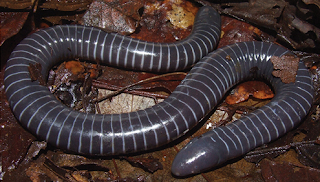 |
| Ringed caecilian, Siphonops annulatus |
Scientists believe they have found evidence that some amphibian ancestors of snakes could have evolved venom. What look suspiciously like venom glands have been found in the ringed caecilian, Siphonops annulatus. Caecilians are a group of legless amphibians that looks superficially like snakes and live mostly underground.
The discovery was made by Pedro Luiz Mailho-Fontana, of the Structural Biology Lab, Butantan Institute, São Paulo, Brazil while examining the mucous glands of the ringed caecilian. The Cell Press press release, quoted in Science Daily, explains:
Caecilians are peculiar creatures, being nearly blind and using a combination of facial tentacles and slime to navigate their underground tunnels. "These animals produce two types of secretions -- one is found mostly in the tail that is poisonous, while the head produces a mucus to help with crawling through the earth," says senior author Carlos Jared, a biologist and Director of the Structural Biology Lab at the Butantan Institute in São Paulo. "Because caecilians are one of the least-studied vertebrates, their biology is a black box full of surprises."
"It is while examining the mucous glands of the ringed caecilian that I stumbled upon a never before described set of glands closer to the teeth," says first author Pedro Luiz Mailho-Fontana, a post-doctoral student in the Structural Biology Lab at the Butantan Institute.
What Mailho-Fontana found were a series of small fluid-filled glands in the upper and lower jaw, with long ducts that opened at the base of each tooth. Using embryonic analysis, he found that these oral glands originated from a different tissue than the slime and poison glands found in the caecilian's skin. "The poisonous skin glands of the ringed caecilian form from the epidermis, but these oral glands develop from the dental tissue, and this is the same developmental origin we find in the venom glands of reptiles," says Mailho-Fontana. This marks the first time glands of this kind have been found in an amphibian.
Researchers suspect that the ringed caecilian may use the secretions from these snake-like oral glands to incapacitate its prey. "Since caecilians have no arms or legs, the mouth is the only tool they have to hunt," says co-author Marta Maria Antoniazzi, an evolutionary biologist at the Butantan Institute. "We believe they activate their oral glands the moment they bite down, and specialized biomolecules are incorporated into their secretions.
The team's findings were published open access in iScience last Friday:

 |
| Structure of the Upper Jaw and Lower Jaw of S. annulatus |
Highlights
- Amphibian caecilians have tooth-related glands in both upper and lower jaws
- The glands have the same origin of reptile venom glands
- The secretion contains proteins with enzymatic activities commonly found in venoms
- Caecilians might have developed the ability to inject oral toxins early in evolution
Summary
Amphibians are known for their skin rich in glands containing toxins employed in passive chemical defense against predators, different from, for example, snakes that have active chemical defense, injecting their venom into the prey. Caecilians (Amphibia, Gymnophiona) are snake-shaped animals with fossorial habits, considered one of the least known vertebrate groups. We show here that amphibian caecilians, including species from the basal groups, besides having cutaneous poisonous glands as other amphibians do, possess specific glands at the base of the teeth that produce enzymes commonly found in venoms. Our analysis of the origin of these glands shows that they originate from the same tissue that gives rise to teeth, similar to the venom glands in reptiles. We speculate that caecilians might have independently developed mechanisms of production and injection of toxins early in their evolutionary history.
Pedro Luiz Mailho-Fontana, Marta Maria Antoniazzi, Cesar Alexandre, Daniel Carvalho Pimenta, Juliana Mozer Sciani, Edmund D. Brodie, Carlos Jared.
Morphological Evidence for an Oral Venom System in Caecilian Amphibians.
iScience, 2020; 101234 DOI: 10.1016/j.isci.2020.101234
Copyright: © The authors. Publisdhed by Cell Press
Open access.
Reprinted under a Creative Commons Attribution – NonCommercial – NoDerivs Licence (CC BY-NC-ND 4.0)
Of course, caecilians, being amphibians, are not themselves ancestors of snakes, which are specialised reptiles, despite their convergent morphology, but the fact that poison glands associated with teeth were probably present in amphibian ancestors of reptiles is evidence for the evolutionary origins of snake venom.


No comments :
Post a Comment
Obscene, threatening or obnoxious messages, preaching, abuse and spam will be removed, as will anything by known Internet trolls and stalkers, by known sock-puppet accounts and anything not connected with the post,
A claim made without evidence can be dismissed without evidence. Remember: your opinion is not an established fact unless corroborated.